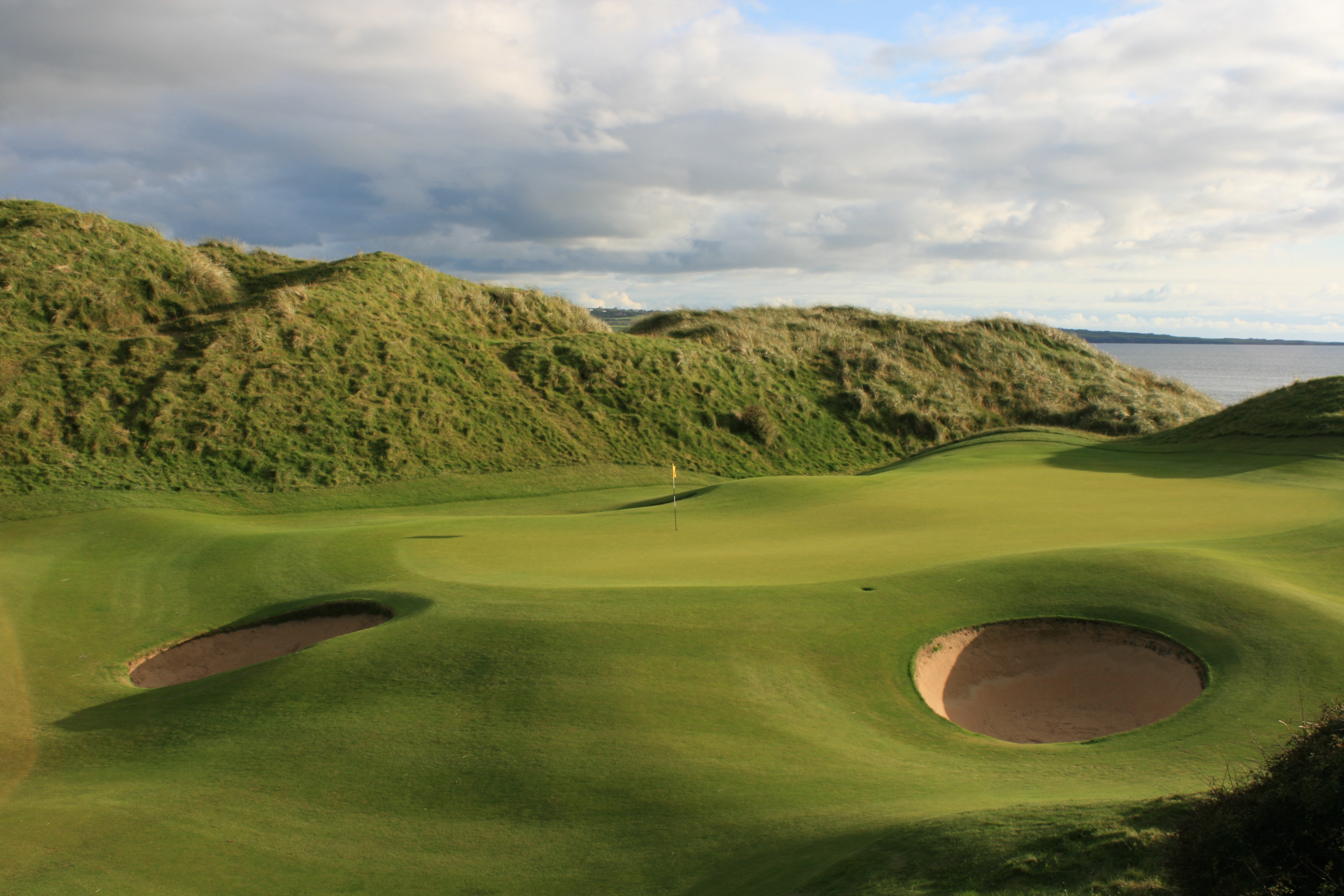Ireland, day one: Lahinch Golf Club, historic and stunning
In the footsteps of Old Tom Morris
LAHINCH, CO. CLARE, Ireland —The fourth hole at Lahinch Golf Club is a par 5 (475 yards from the blue tees, 472 from the white tees, 463 from the green tees that I played) that was inspired by the Klondyke hole that Old Tom Morris designed here in 1894:
The golfer must hit a narrow fairway between two massive, wild grass-covered sand dunes, then clear another dune, the Klondyke Hill, in a blind shot to the green. On Wednesday, my tee shot found the rough on the right-side dune, and my second shot left me 200 yards from the green, somewhere behind Klondyke Hill. The white-haired Irishman at the top of the hill — stationed to protect golfers on the 18th fairway that crosses behind it — gave me a rough line.
Not so confident that I didn’t warn the spotter to watch carefully — the gentleman immediately retreated a few paces beyond the logical line of fire, which didn’t necessarily guarantee safety — I hit a three-wood that cleared the hill rather impressively.
“Good shot,” the Irishman called. “Well done!” The shot had stopped on the back of the green, and two putts later I had my first par ever outside the continental United States. That it was my only par of the day … well, it’s still a shot that this 19-handicapper will remember, along with the spotter’s praise, given the history of this place, the roots of the hole.
Thanks to the courtesy of Tourism Ireland, represented by Bernard McMullan, I played Lahinch with three Northwest journalists from the Seattle area — Blaine Newnham, the former sports editor and columnist of the Eugene Register-Guard and the longtime columnist for the Seattle Times and author of “America’s St. Andrews” about U.S. Open site Chambers Bay; Tom Cade, senior director of communications for the Pacific Northwest Golf Association and editor of Pacific Northwest Golfer Magazine, who plays to a 2 handicap, and Rob Perry, of Bellevue, Wash., a professional photographer of all things golf, who plays to a 3.6.
In my case, getting to Lahinch, on the Atlantic coast in southwest Ireland, meant driving to Portland International Airport late Monday night for a 5:20 a.m. Tuesday flight to Phoenix then Philadelphia, where I met the rest of the group and we flew late Tuesday night to Shannon, Ireland, arriving at 8:30 Wednesday morning and driving to Lahinch, where we played shortly after noon. A long way, and not much sleep, but I would have walked here, of course.
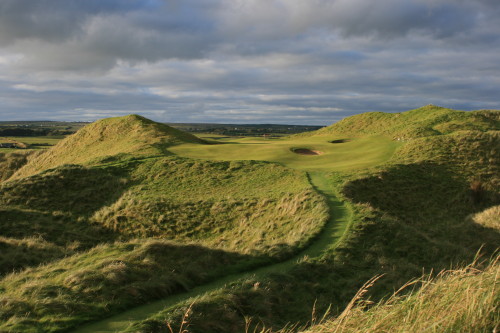
Don’t be short at No. 8 at Lahinch Golf Club.
Wrote Tom Coyne in “A Course Called Ireland,”: “Lahinch fell on the first page of most global golf course rankings, a links built in 1892 by Limerick golfers looking for a summer track and Scottish soldiers stationed in Lahinch. Golfers had made pilgrimages to Lahinch’s dunes ever since.”
Last year, Golf Digest ranked it No. 64 in the world: “Considered by some the St. Andrews of Ireland, the splendid links at Lahinch reflects evolution in golf architecture. After Alister MacKenzie remodeled it in the 1920s, only a few of Old Tom Morris’s original holes, like the Klondyke par-5 , and Dell par-3 , both with hidden greens, remained. In the 1980s, Donald Steel altered some of MacKenzie’s holes and in the 2000s Martin Hawtree rebuilt everything and added four new holes.”
The course is ranked No. 40 in the world by Golf.com’s panel of experts.
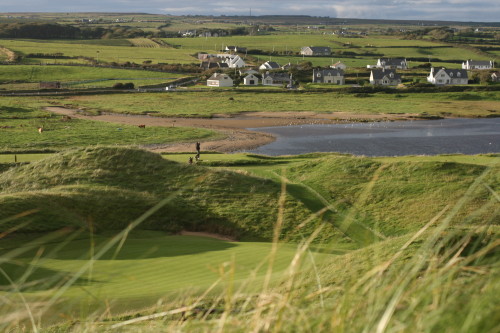
Alan Clohessy tees off on No. 12 at Lahinch Golf Club in southwest Ireland.
And an amazing, special course it is, the dunes formidible, the grass in the rough long and impossible, especially for this inept golfer who doesn’t have certain shots, like the one where you stand on the side of a dune, the ball at waist level, deep in grass. (The bigger issue is to not hit it up there in the first place, but …. ) The course, with its postcard views of Liscannor Bay, and of the village of Lahinch, is somehow “bigger” to me, if that’s the right word, than the links courses at Bandon Dunes, for example — the dunes seemingly more massive. It’s a course that’s tough, but playable, if you keep it in the fairway — and a disaster if you don’t.
(Perry, who like Cade is a really, really good golfer and totally not arrogant about it, a joy to play with, shot 78 playing from the whites; Cade had eight pars and was in the low 80s; Newnham won the match of former Register-Guard sports columnists, with the stakes a pint of Guinness. Wish I had played better, and being north of 110 was grueling at times; had two nines and two eights, and it wasn’t all the golf course, but any means. Ball count — lost one, found three.)
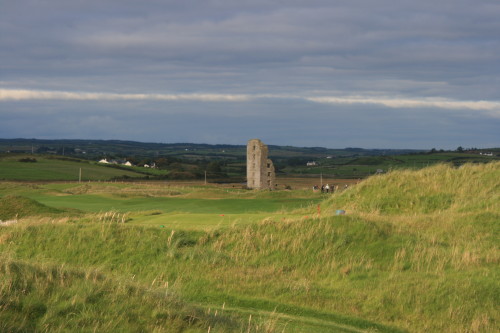
The ruins of Dough Castle are an aiming point at No. 12.
But if you come here, don’t make the scorecard the judge of the experience. There are fantastic holes on this course — virtually every one of them special in some way, with something unique, maybe except for 18, a long par 5 with a “well, you have to get back to the clubhouse somehow” feel.
My favorites:
No. 4, of course. No. 5, a short par 3, the last surviving true Old Tom Morris hole, called The Dell, with a dune hiding most of the green; No. 6, a tough par four heading through the dunes and over a huge blowout hole, with a bunker at the bottom, to a green framed by the bay; No. 7, a par 4 heading north along the water; No. 8 and No. 11, both beautiful and tough par 3s; and No. 12, a long par 5, river to the left, the ruins of Dough Castle, dating to 1306, in the distance.
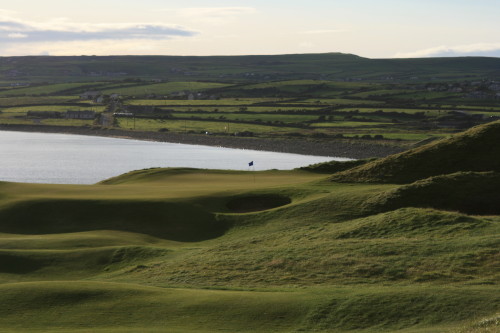
No. 7 at Lahinch Golf Club, on Liscannor Bay.
After our round, Perry and I went back to take photos; the sun broke through the clouds (we had no rain, and moderate wind, a near-perfect day by links standards) and the light was perfect. On the sixth fairway we chatted with Alan Clohessy, a young greenskeeper who plays to an 8-handicap and clearly loves the course, who talked about its importance to the community, built on tourism. An hour or so later we saw Clohessy again — his duties done, he was playing the course is the soft light of late day.
(From the starter who explained in detail the best routes to take on some of the blind-shot holes, to the spotter on No. 4, to Clohessy on his mower, people couldn’t have been nicer here, there’s a great feel to Lahinch. The same is true for the people at the place we stayed in Lahinch, Lahinch Golf & Leisure Hotel.
Weekday green fees for Lahinch at high season are 150 Euros, or about $167. I may never again get back here, but I’ll always want to play this course again.
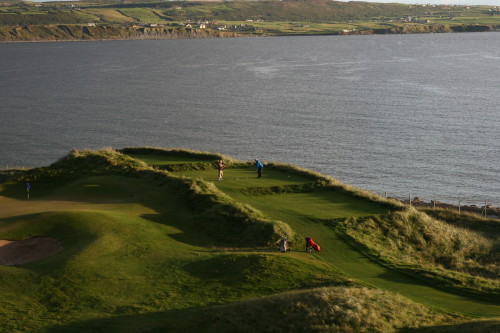
A golfer tees off on No. 7 at Lahinch.
